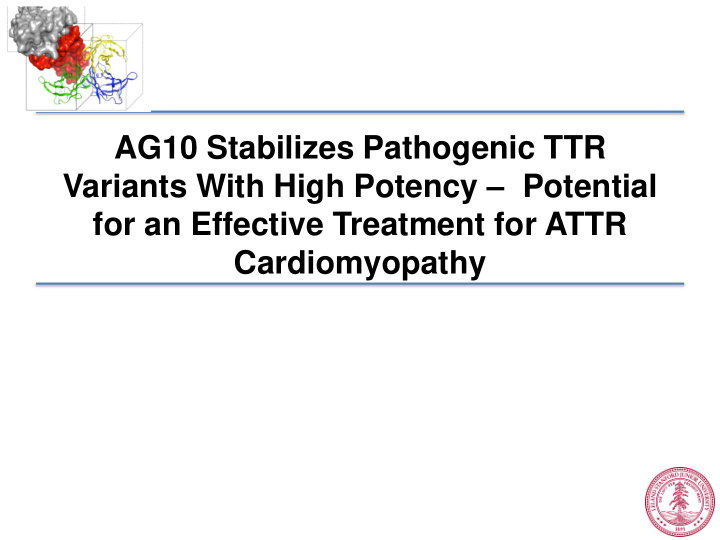



AG10 Stabilizes Pathogenic TTR Variants With High Potency – Potential for an Effective Treatment for ATTR Cardiomyopathy
ATTR-Cardiomyopathy (CM) And ATTR- Polyneuropathy (PN) Are Caused By Aggregation Of Misfolded TTR Monomers
TTR amyloidosis is a systemic disorder Leptomeningial ATTR cardiomyopathy (ATTR-CM) Amyloidosis Ocular Manifestations • Deposition of mutant (i.e. V122I) or wild-type TTR amyloid in the heart • Leads to predominantly diastolic heart failure • Afib/stroke and heart block frequently seen • Affects > 200,000 patients worldwide Multisystem Disease, High • Late onset (50-60+), death within 4-6 years Disease Burden • No FDA approved treatment Nephropathy GI Manifestations ATTR polyneuropathy (ATTR-PN) Carpal Tunnel • Syndrome Affects ~10,000 patients worldwide, mostly EU &Japan • Deposition of mutant TTR (i.e.V30M) amyloid in peripheral nerves • Autosomal dominant with variable penetrance • Leads to sensorimotor & autonomic deficits • No FDA-approved treatments Source: Grogan, M et al. JACC 2016, 68:1014-20; Planté-Bordeneuve, V. et al, Lancet Neurol 2011, 10:1086-97
Does AG10 Stabilize a Broad Range of Pathogenic TTR Variants? V122I: Cardiomyopathy T60A: Cardiomyopathy & polyneuropathy P24S: Cardiomyopathy & polyneuropathy D38A: Cardiomyopathy & polyneuropathy L58H: Cardiomyopathy &polyneuropathy F64L: Polyneuropathy Y114C: Polyneuropathy with leptomeningeal complications
AG10 Stabilizes Mutant TTR from V122I ATTR Patients FPE Assay: Change in fluorescence due to modification of TTR in human serum by a covalent probe, which becomes fluorescent following binding to TTR. The lower the binding of the probe/fluorescence the higher the binding selectivity and affinity of the ligand to TTR. AG10 was used at 10 m M
AG10 Stabilizes Mutant TTR from T60A ATTR Patients
AG10 Stabilizes Mutant TTR from P24S ATTR Patients
AG10 Stabilizes Mutant TTR from D38A ATTR Patients
AG10 Stabilizes Mutant TTR from L58H ATTR Patients
AG10 Stabilizes Mutant TTR from F64L ATTR Patients
AG10 Stabilizes Mutant TTR from Y114C ATTR Patients
Does AG10 Stabilize a Broad Range of Pathogenic TTR Variants? - YES
AG10 has a unique binding mode, which mimics the effect of the TTR trans-suppressor mutation - T119M The naturally occurring trans-suppressor mutation AG10 binding to TTR mimics the stabilizing T119M super-stabilizes TTR interactions of T119M variant to S117 • The T119M polymorphism creates H-bonds • within the complex that super-stabilize the AG10 mimics the structural effects of TTR tetramer and functions as a trans- T119M. suppressor mutation in V30M carriers. • Stabilization of TTR by AG10 may mimic • T119M heterozygotes have a 5-10 year the clinical effect and lead to improved longer life-span and significantly lower risk outcomes of cerebrovascular disease Hammarström et al, Science , 2001, 293:2459-62 Sebastiao et al, J. Mol.Biol . 2001, 306, 733-44 Hornstrup et al, Arterioscler Thromb Vasc Biol , 2013, 33(6), 1441-7 Miller et al, unpublished data Penchala et al. Proc Natl Acad Sci USA, 2013, 110:9992-7
Coworkers and Collaborators University of the Pacific: Johns Hopkins University: Mark Miller Yi Z.J. Lee Mamoun Alhamadsheh Dan Judge Eidos: Stanford University: Uma Sinha Ron Witteles Robert Zamboni Michaela Liedtke Jonathan Fox Neil Kumar
TTR Mutations • > 100 mutations in the TTR gene have been found to cause TTR amyloidosis (ATTR). • Most of these alter the TTR structure, resulting in either kinetic or thermodynamic destabilization • The most common ATTR mutations are V122I (3.4% of African Americans) and V30M.
Discovery and Development of AG10 • • HTS of 130,000 identified 32 compounds AG10 was the most potent analogue with the with IC50 <1 m M best physicochemical properties • Crystal structure of top novel ligands • AG10 was selected for ADME and Toxicity studies • • The crystal structure of Ligand 7 was IND was filed in August 2017 and Phase used as a starting point for SAR 1 clinical studies started in September studies . 2017 Alhamadsheh et al, Science Transl Med, 2011, August 24, Vol.97 Penchala S. et al. Proc Natl Acad Sci USA, 2013, 110:9992-7
AG10 binds with high affinity and high selectivity to human serum TTR
Recommend
More recommend